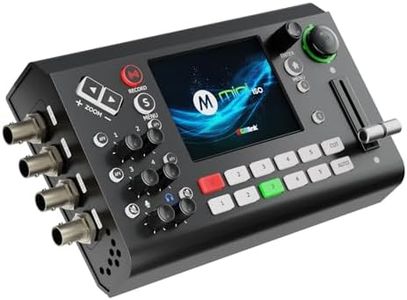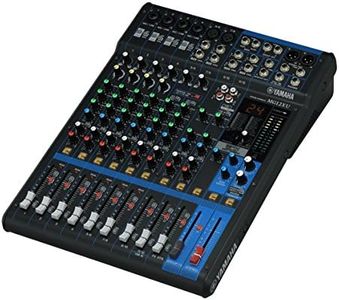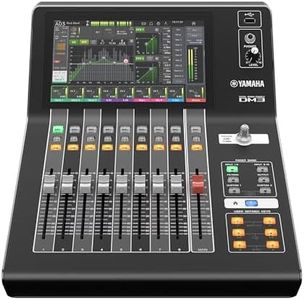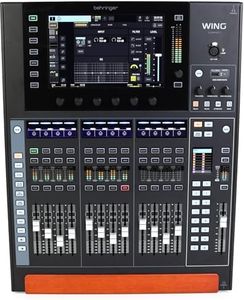10 Best Digital Mixers 2026 in the United States
Our technology thoroughly searches through the online shopping world, reviewing hundreds of sites. We then process and analyze this information, updating in real-time to bring you the latest top-rated products. This way, you always get the best and most current options available.

Our Top Picks
Winner
Yamaha MG16XU 16-Input 6-Bus Mixer with Effects
Most important from
3972 reviews
The Yamaha MG16XU is a solid choice if you need a 16-channel digital mixer with versatile features for live sound or recording. It offers a good number of mic and line inputs—10 mics with combo and XLR jacks—making it flexible for different setups. The built-in SPX digital effects and 1-knob compressors help you shape your sound easily, adding polish without complicated controls. Its 3-band EQ and high-pass filters are effective for cleaning up your mix by reducing unwanted noise. The sound quality benefits from Yamaha’s class-A D-PRE preamps, which provide a warm and natural tone.
Connectivity is boosted by USB, allowing straightforward recording and playback with a computer, though advanced software integration isn’t a highlight here. The user interface is straightforward, designed to be intuitive even if you’re new to mixers, though it’s more traditional and lacks a touchscreen or extensive digital menus. Weighing nearly 15 pounds and built with a sturdy metal chassis, it’s durable but not very portable if you need something lightweight for frequent travel. The mixer’s power comes from a corded electric source, so it’s best suited for fixed locations or gigs with easy access to power.
The MG16XU offers a balance of powerful sound control and reliable build quality, making it ideal for musicians, DJs, or small bands looking for an affordable yet capable mixer without extra bells and whistles.
Most important from
3972 reviews
Behringer 32 40-Input 25-Bus Digital Mixing Console, Black (X32)
Most important from
365 reviews
The Behringer X32 Digital Mixer is a robust choice for both live sound and studio applications, primarily due to its impressive feature set. It boasts 40 input channels and 32 gain-programmable mic preamps, which means it can handle complex audio setups with ease. One of its key strengths is the built-in effects processor, offering users a variety of sound-shaping options right at their fingertips. The 7-inch color TFT display provides clear visuals, making navigation straightforward, even for those who may not be overly familiar with digital mixers. Additionally, the 25 motorized faders allow for precise control and automation, which is especially useful during live performances or recordings.
This mixer isn't perfect. Its weight of nearly 63 pounds makes it less portable, which might be a drawback for users looking for something easily transportable. The size is also considerable, measuring over 40 inches in depth, which can be cumbersome in smaller setups. While it does offer USB connectivity for recording, some users might find the software integration options limited compared to other high-end mixers.
The Behringer X32 is well-suited for seasoned audio professionals and those who require extensive input options and effects. For beginners or those needing a more compact and lightweight solution, it might be wise to explore other alternatives. Its combination of features makes it a powerful tool for anyone serious about sound mixing; just keep in mind its size and weight when considering how and where you'll use it.
Most important from
365 reviews
Yamaha MG12XU 12-Input 4-Bus Mixer with Effects
Most important from
3972 reviews
The Yamaha MG12XU is a 12-channel digital mixer ideal for musicians and small to medium live sound setups. It offers studio-quality sound thanks to its class-A D-PRE preamps, which deliver clear and natural audio with strong bass and smooth highs. The built-in SPX digital effects add versatility without needing extra gear, and the 3-band EQ plus high-pass filters help clean up your mix by reducing unwanted noise. One of its user-friendly features is the 1-knob compressors, which make it simple to improve dynamics on vocals, guitars, and drums without complicated settings.
In terms of connectivity, the USB interface allows easy direct recording to a computer, fitting well for those wanting to capture performances or podcasts. The mixer’s metal chassis is sturdy, making it durable for regular use, but it weighs over 10 pounds and has a somewhat bulky size, so it’s less convenient if you need something very portable.
The user interface is straightforward for basic mixing needs, though it lacks some of the more advanced touchscreen controls found on newer models. The Yamaha MG12XU suits users who want a reliable, quality mixer with useful built-in effects and strong sound shaping tools, especially for live or home studio use, but it may feel a bit heavy and less modern compared to newer compact mixers.
Most important from
3972 reviews
Buying Guide for the Best Digital Mixers
Choosing the right digital mixer can significantly enhance your audio production experience, whether you're working in a studio, live sound environment, or broadcasting. Digital mixers offer a range of features and capabilities that can cater to different needs and preferences. To make an informed decision, it's important to understand the key specifications and how they align with your specific requirements. Here are some essential specs to consider when selecting a digital mixer.FAQ
Most Popular Categories Right Now




















